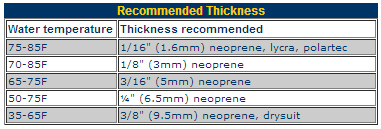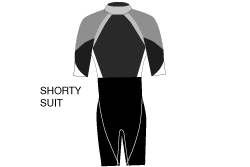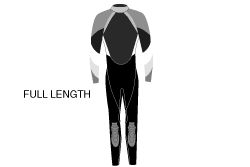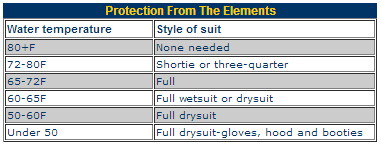Wetsuit
From thickness to style to construction, our guide helps you select a suit for your aquatic adventures.
How To Buy A Wetsuit
Wetsuits protect you from the elements so your main consideration centers on water conditions. You can find wetsuits that provide the protection you need based on the water temperatures and depths of your typical diving conditions.
Choosing the proper wetsuit
There are many factors involved in determining the proper wetsuit for your diving abilities and style.
Dive Conditions
The diving conditions you prefer determine the style and thickness of wetsuit you need. Water temperatures and depths are the key considerations.
Water temperatures and depths
- Water temperature
- The warmer the water, the less protection you need; the colder the water, the more protection you want.
- Water Depth
- Depth may be even more important than water temperature because neoprene--the most common material used in wetsuits--compresses with depth, losing its insulation value. Typically, most neoprene wetsuits lose half their insulation value at 60 feet.
Insulation
Wetsuits insulate your body in two ways:
- First, they trap a thin layer of water between your suit and skin to reduce heat loss. That's done by the neoprene, which traps nitrogen bubbles to provide the insulation.
- Second, by keeping cold water away from your skin, you receive further insulation
Thickness
- Thickness is expressed in inches and millimeters
- Thicker wetsuits provide greater insulation, but the quality of the material plays a part as well
- If your diving conditions vary from the extremes, you should buy the thickest wetsuit to cover your needs
- Refer to the chart below to help determine the appropriate wetsuit based on the water temperatures where you plan to do your diving


Styles
There are also a variety of wet suit styles to fit your diving conditions.
Shorties
- These are one-piece, short sleeve shirt and short set

Three-quarter
- This one-piece set has short sleeves and legs that extend to the ankles
Full-length
- This suit has long sleeves and legs that extend down to the ankles
Full suit
- A one-piece suit from neck to ankles
- Some styles give you the option to buy a suit with long or short legs
Farmer John/Jane
- Two-piece suits that offer a better fit if you have an odd leg-to-torso figure
Dry suit
- If your diving conditions are in really cold water or deep depths, you may want to consider a drysuit
- Designed to keep as much water out as possible by using rubber seals around the neck, wrists and ankles
- Some also use Velcro-style straps around the wrists and ankles to provide an extra measure of sealing
Determining the proper style
The chart below gives you guidance but you should also consider another factor--protection from the elements. Even a thin suit that covers your arms and legs gives you some protection from sun and scrapes.

Wet suit accessories
Hats/Hoods
- You lose nearly 40 percent of your body heat through your head
- A hood is a must for extremely cold diving
Booties and gloves
- Provide insulation for your extremities
- These also increase your protection from abrasion
- Booties help make your fins more comfortable
Vest or jacket
- These come in handy when your diving conditions change
- Allow for layering
Fitting a wetsuit
- A well-fitting wetsuit increases insulation and comfort
- They should fit snugly but shouldn't restrict your movement or breathing
- If a suit is too loose, you allow water to enter, defeating its purpose
- A wetsuit should be sized similarly to your regular clothes
Materials and construction
- Most wetsuits and drysuits use neoprene, a synthetic rubber that is waterproof, insulated and flexible
- Lycra, a type of nylon, is used in thinner suits. These are more flexible buy are most appropriate for diving in warm and shallow waters.
- The inside and outside of wetsuits and drysuits typically have a nylon fabric laminated to the neoprene. This helps resist tearing and abrasion.
- Manufacturers use different stitching techniques to increase the seal at the seams. These are usually glued and blindstitched or glued and taped.